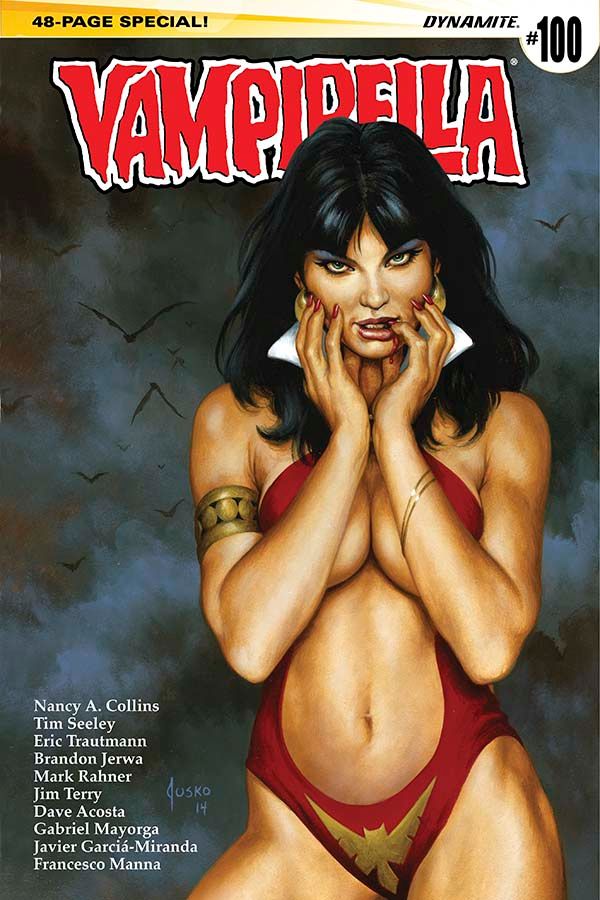Rather than deliver a single extra-sized adventure, "Vampirella" #100 gives readers five stories in an anthology format. A distinct creative team handles each story, with Marshall Dillon providing letters for the entirety of this forty-eight-page anniversary issue. Instantly recognizable to fans everywhere, Vampirella maintains some semblance in her trademark red swimsuit.
"Vampirella" #100 opens with "Vampirella of Drakulon" as written by Tim Seeley with art from Jim Terry, the creative team behind "Sundowners." This adventure is framed within a color sequence that treats the majority of the tale as a flashback or dream. That's not to say there isn't adventure and excitement, though, as Seeley and Terry return to the black and white roots of Vampirella's original stories from Warren Publishing. Set on her homeworld of Drakulon, Vampirella's quest is one of sustenance and justice as Seeley and Terry give readers a sharp encapsulation of what Vampirella is all about. Terry's art looks like it was lifted from an old black and white magazine, using halos and hotspots to help define depth and shape while the gray tones flesh out the rest of the Drakulon adventure. This a solid start for the issue and gives readers a sense of what could have been -- or maybe what still is -- for the character.
From there, "Vampirella" #100 focuses on more current and local adventures, leaping to Chicago for "The Vodnik," written by Eric Trautman and drawn by Dave Acosta. Dillon shakes up the letters here a bit as Vampirella runs into Lubos, a Vodnici or Czech water troll. The troll's word balloons appear more hand-lettered than computer-generated and give the character a shaky gruffness that fits the appearance Acosta draws. Colorist Salvatore Aiala Studios brings murkiness to the setting, melting colors into Acosta's heavy inks as Vampirella seeks answers from her diminutive opponent in a classic story of one-upsmanship. Trautman makes it quite clear in this tale that Vampirella is fighting for what's right, rather than fighting just to fight, as he showcases her intelligence and dedication before reminding readers just how swift and violent she can be.
"A Closer Walk With Thee" pitches Vampi into a graveyard, seeking answers from the departed there. The first page is visually rough as Gabriel Mayorga tries a little too hard to define Vampirella's musculature and colorist Dijjo Lima does the same, which just amplifies the serviceable art. The two have some other weird combinations throughout the story but, for the most part, they work well together in a tale that uses Vampirella more as a plot device, where she serves more as a story Sherpa, like Phantom Stranger used to do in the Silver Age. Writer Brandon Jerwa gives readers a mystery to follow but not enough clues to solve the puzzle on their own before he wraps up his adventure.
"Kovak the Night Walker" from writer Mark Rahner and artist Javier GarcÃa-Miranda checks in on Cal Kovak. The story reflects on his career, which benefitted from Vampirella's appearances. This chapter contains a richer art style with its drawn in shading and figures reminiscent of Pat Broderick's work from the 1980s. It's a nice bit of art for a flashback as Rahner's story walks the line between Vampirella as heroine and plot device. She's not fighting a specific foe here, but her presence is noteworthy.
"A Cry in the Jungle" closes out "Vampirella" #100 as Nancy A. Collins and Francesco Manna give readers a straight-up horror story filled with vampiric baby tianaks. Collins' story seems more apt for other media because of the way her storytelling liberties are applied. It opens with a couple walking towards grass huts, discussing a movie they just saw despite the complete absence of anything that is not found in a stereotypical, B-grade jungle setting. The climax takes another large leap in storytelling as Vampirella pulls in assistants -- from her pockets? Odd conveniences hamstring Collins' story throughout, but the horror element is strong enough to hold attention. Mundane coloring for this tale washes everything into murkiness, save for Vampirella's red attire and blood as Manna plays with perspectives and poses, adding more B-movie atmosphere. The horror story closing out "Vampirella" #100 has either an amazingly fun cliffhanger or a woefully lackluster and anti-climatic conclusion depending on what Dynamite decides to do from here. I'm hopeful for the former, and I'm sure lots of reader would love to get more Vampirella written by Nancy A. Collins.
Overall, "Vampirella" #100 is a diverse collection of stories, each offering a distinct take on Vampirella, but nothing really sets this apart as celebratory or distinguishable despite its extra length. There's some good stuff and some mediocre stuff, the former thankfully outweighing the latter, but nothing in this comic is as spectacular as a one-hundredth issue of a comic book icon deserves. "Vampirella" #100 is a nice slideshow, but readers should expect nothing but a dynamic documentary.

